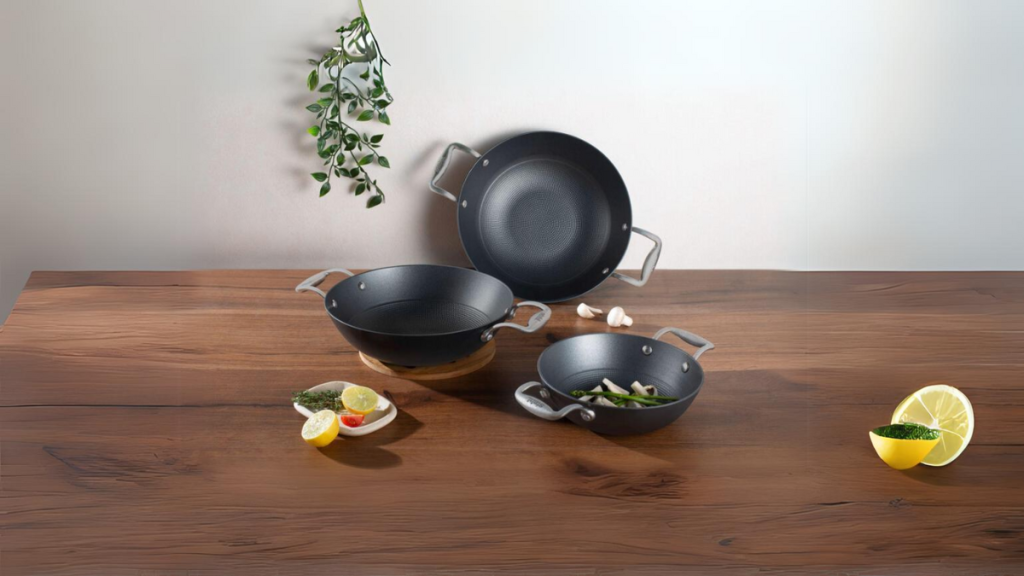The Indian culinary saga is incomplete without kadhai, which has made itself irreplaceable in Indian kitchens. It’s enduring presence through your culinary journey validates it, doesn’t it? For time immemorial, the position was ruled by the traditional cast iron kadai, but with the introduction of its contemporary counterpart, the innovative Stahl cast iron kadai, one might be torn as to which of these suits their present kitchen needs. Let’s dive into what makes these kadais unique and beneficial for you to make a conscious decision.
Traditional Cast Iron Kadhai vs. Stahl Cast Iron Kadhai
The tale truly begins with the traditional cast iron kadai made with molten iron and cast into its classic shape, this kadai exudes an old-school charm. The Stahl Cast Iron Kadai, on the other hand, is an innovative take on the traditional cast iron but with more finesse to make cooking convenient and enjoyable. Read on to learn what else they bring to the table.
1. Weight
Weight plays an important factor when choosing the right cast iron cookware. For a traditional cast iron kadai to be strong and durable, it has to be thick and heavy. The Stahl cast iron kadhai shines in this department. It is designed to weigh up to 50% lighter and perform just as well as the traditional cast iron. Choose Stahl for a lighter alternative to the heavier cast iron.
2. High Heat Retention
Cast iron is renowned for having a higher heat resistance and retention capacity compared to other metals. This makes both the kadai variants ideal for Indian cooking techniques. You can use any of these kadais for curries, deep-frying, stir-frying, etc.
3. Durability
Both these variants of cast iron kadhai are built for durability and longevity. They can last for decades; you can proudly consider them your kitchen heirloom and pass them down to the next generation. However, if the weight of the cookware, which we’ve addressed above, is a matter of concern, go for newer & better Stahl kadai.
4. Reactivity With Food
While the traditional cast iron kadai reacts significantly with most foods, especially acidic foods, and leads to discoloration and change of taste, the Stahl cast iron kadai is non-reactive. Stahl cast iron preserves the original taste, color, and also the nutritional value of the foods cooked in it, making it convenient for everyday cooking.
5. Kadhai Handles
What’s the fun in cooking if you cannot maneuver the cookware your way? One way to do that is to choose the kadai with handles that don’t heat up as much as the rest of the body. Generally, cast iron kadai handles are cast along with the cookware and they heat up quickly, making it inconvenient and unsafe to manage the cookware while cooking. The Stahl cast iron kadai comes with stainless steel stay-cool handles which do not get as hot, allowing you to maneuver it with ease.
6. Compatibility With All Cooktops
Since cooktops have evolved by leaps and bounds, you must choose the right kadai that is compatible with your cooking range. Both these variants of kadhai can be conveniently used on stovetops, inductions tops, and also the OTG.
7. Seasoning and Less Oil Usage
Iron is corrosive in nature; the moment it comes in contact with air or water, it starts rusting. You must, therefore, season the traditional cast iron kadhai after every use. The Stahl cast iron kadhai comes with a highly safe and durable enamel treatment done at high temperature that makes it stick-resistant and rust-proof. The convenience of not seasoning after every use does win your heart, doesn’t it? Also, with Stahl, you’ll be cooking food in less oil, ensuring it is healthier.
8. Ease of Cleaning and Maintenance
With a rust-proof surface, the Stahl cast iron kadhai is hands down the easiest to clean and maintain, whereas the traditional cast iron needs a good amount of scrubbing and a layer of seasoning to prevent corrosion. You can just clean the Stahl cast iron with a mild liquid dishwash, wipe it dry, and store it hassle-free without seasoning.
To conclude, both the kadhais bring their own flair to the kitchen. Choosing one is completely based on your culinary preferences and convenience. By now, you must be equipped with enough information to choose the right cast iron companion for your needs.




